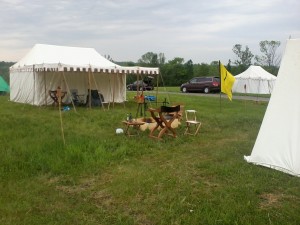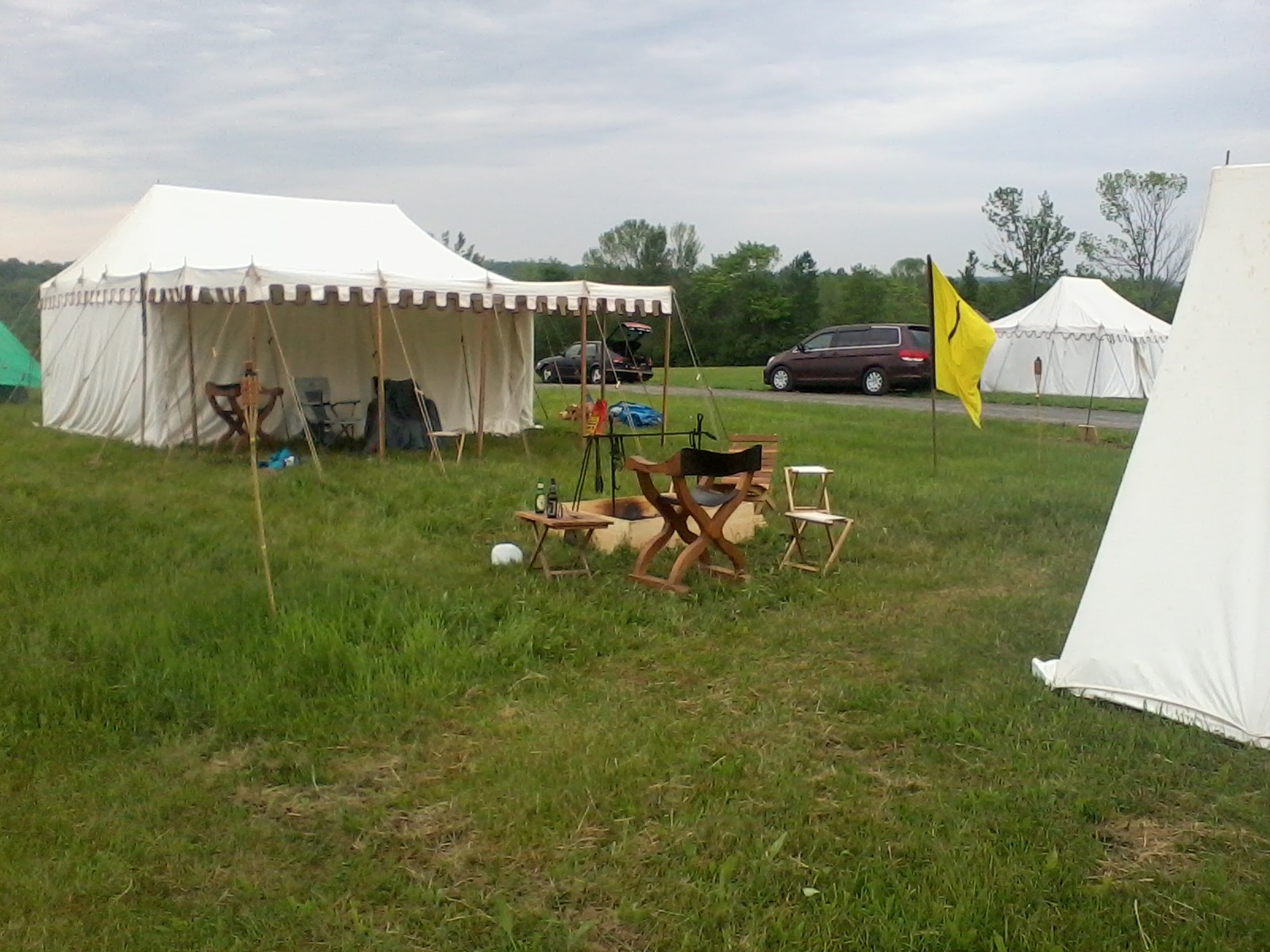
The War of the Roses in Concordia is a three-day event in beautiful upstate New York. We were hosted at the camp of Baron Master Angus Pembridge, at Pembridge Manor. One of the best parts of the camp was the large fire box Angus had built, raised and made of wood, with a bottom consisting of 300lbs of masonry sand. While a lot of great things happened at the event, this post is just about the food and how we cooked it.
Dinner Saturday: Marigold, a lovely but (fatally) inappropriate farm cow, was the guest of honor. Cooked in a large cast iron pan over a hot-coal fire by Angus as Katheryn, who actually asked Sir Walter Raleigh how to cook the new world vegetable BEFORE assuming we boil the tops, took the tuberous roots from the potatoes and boiled them to good effect.
Breakfast Sunday: fresh farm eggs and handmade home-cured bacon. Eggs cooked in the standard fashion, but the bacon was fried over hot coals in a large cast-iron pan. After eating that bacon, all other bacon in the world is almost an insult to it. We reserved the grease, which would be important for everything else!
Lunch Sunday: Drew and I prepared Saturday’s lunch, which was onion cooked in bacon fat, and then we added two jars of moose meat which had been cooked with onion and canned (by Drew’s mother) after he got a moose a while back. To this mix we added a generous pour of red wine, some black pepper and salt and what cooked potatoes had lasted from the night before. We also made ployes, a French-Acadian buckwheat and wheat pancake, which are traditionally served with stews. We had maple syrup for dipping them as well, so they were both the starch for the meal and a light desert.
Dinner Sunday: Making this dinner was one of the best SCA experiences I have ever had. The end result was Coneys Stewed with Wine and Herbes de Provence and Ginger Bourbon Coney, fresh green beans, and potatoes pan fried with onions and rosemary.
Angus provided three rabbits, which had been skinned and dressed, to a degree. We chopped them (one by Angus, one by my own hand, and the third by Isabel Chamberlaine) into large pieces (about 6 pieces per rabbit) for cooking, which was entirely over the Pembridge Pit. Our recipes are as follows, or are at least as good as I can remember them, because it was a fury of cookery going on:
Coneys Stewed with Wine and Herbes de Provence
2 onions, chopped small and sauteed to clear in bacon grease
1/4 cup maple syrup (roughly) added to onions
pepper and salt added to the onions
2 rabbits, cut to fit in the pot
2 cup Cotes du Rhone (or other red wine, we picked what tasted “right” from what was in stock at camp, a terrible process, of course….)
2-3 tbs blend of Herbes de Provence (ours included generous lavender…)
some water as needed
We let it boil merrily over the fire for a couple of hours, periodically opening the pot to exclaim and congratulate ourselves on how lovely it smelled. We took all the rabbit out at one point to shift the top pieces and bottom pieces so everything would cook at about the same rate.
The resulting dish was intensely fragrant, causing a ruckus every time we opened the cauldron. The meat was sweet, tender, and succulent. The broth was a beautiful purple, appropriate for the lavender influence of the herbes de Provence. Everyone who tried this dish was greatly impressed with its flavor, and it is a true pity there was no way to make stew dumplings for it, because they would have been spectacular. (We boiled it again the next morning for lunch, and it was, remarkably, even better the next day!)
Ginger Bourbon Coney in Dutch Oven
1 onion clarified in bacon grease
a generous pour of Maker’s Mark Bourbon (add just when the onions are almost dry…)
1 rabbit, cut into about 6 pieces
salt, pepper, powdered ginger (to taste / by instinct)
a little water as needed
We heated the pan and onions up well, and there was a good amount of bacon grease added to this dish. The bourbon caramelized the onions and the ginger gave the little flavor beyond pepper and salt that it needed. As there was less liquid, the rabbit also got a caramel flavor and the skin seared where it touched the pan, which was close to low, hot coals. The rabbit was turned half-way through the cooking, and water was added, which brought up a sizzling cloud of fragrant steam, which made us dance with anticipation. The taste of this was less intense than the other dish, but I liked it a little better, maybe because of the sweetness of the bourbon and onions.
Monday Morning: Plain, slender, civilian bacon cooked on the cast iron skillet over the fire; French toast with potato bread and farm eggs, with maple and black pepper peaches on top (for those patient enough to wait), and fluffy scrambled eggs with the remainder of the eggs. We used up a really good amount of food that morning, making the packing up a little better.
Monday Leaving Lunch: My last taste of the War of the Roses was of the Coneys Stewed with Wine and Herbes de Provence, which tasted even better after lying in the stew all night and being boiled up again. It was like a sweet, sweet kiss of farewell to Pembridge Manor, and I savored the last moments before the long road back to home and daily life….

